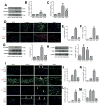Transforming Growth Factor-β1 Inhibits Pseudoaneurysm Formation After Aortic Patch Angioplasty
- PMID: 29146747
- PMCID: PMC5746454
- DOI: 10.1161/ATVBAHA.117.310372
Transforming Growth Factor-β1 Inhibits Pseudoaneurysm Formation After Aortic Patch Angioplasty
Abstract
Objective: Pseudoaneurysms remain a significant complication after vascular procedures. We hypothesized that TGF-β (transforming growth factor-β) signaling plays a mechanistic role in the development of pseudoaneurysms.
Approach and results: Rat aortic pericardial patch angioplasty was associated with a high incidence (88%) of pseudoaneurysms at 30 days, with increased smad2 phosphorylation in small pseudoaneurysms but not in large pseudoaneurysms; TGF-β1 receptors were increased in small pseudoaneurysms and preserved in large pseudoaneurysms. Delivery of TGF-β1 via nanoparticles covalently bonded to the patch stimulated smad2 phosphorylation both in vitro and in vivo and significantly decreased pseudoaneurysm formation (6.7%). Inhibition of TGF-β1 signaling with SB431542 decreased smad2 phosphorylation both in vitro and in vivo and significantly induced pseudoaneurysm formation by day 7 (66.7%).
Conclusions: Normal healing after aortic patch angioplasty is associated with increased TGF-β1 signaling, and recruitment of smad2 signaling may limit pseudoaneurysm formation; loss of TGF-β1 signaling is associated with the formation of large pseudoaneurysms. Enhancement of TGF-β1 signaling may be a potential mechanism to limit pseudoaneurysm formation after vascular intervention.
Keywords: TGF beta; animal model; nanoparticle; pseudoaneurysm; smad2.
© 2017 American Heart Association, Inc.
Figures






Similar articles
-
A novel intramural TGF β 1 hydrogel delivery method to decrease murine abdominal aortic aneurysm and rat aortic pseudoaneurysm formation and progression.Biomed Pharmacother. 2021 May;137:111296. doi: 10.1016/j.biopha.2021.111296. Epub 2021 Feb 3. Biomed Pharmacother. 2021. PMID: 33545663
-
TGF-[beta]1 limits plaque growth, stabilizes plaque structure, and prevents aortic dilation in apolipoprotein E-null mice.Arterioscler Thromb Vasc Biol. 2009 Sep;29(9):1251-7. doi: 10.1161/ATVBAHA.109.186593. Epub 2009 Mar 26. Arterioscler Thromb Vasc Biol. 2009. PMID: 19325140 Free PMC article.
-
Positive correlation between the dysregulation of transforming growth factor-β1 and aneurysmal pathological changes in patients with Marfan syndrome.Circ J. 2013;77(4):952-8. doi: 10.1253/circj.cj-12-0874. Epub 2012 Dec 28. Circ J. 2013. PMID: 23291965 Clinical Trial.
-
Role of ALK5/Smad2/3 and MEK1/ERK Signaling in Transforming Growth Factor Beta 1-modulated Growth, Collagen Turnover, and Differentiation of Stem Cells from Apical Papilla of Human Tooth.J Endod. 2015 Aug;41(8):1272-80. doi: 10.1016/j.joen.2015.03.022. Epub 2015 May 19. J Endod. 2015. PMID: 26001858
-
The TGF-β pathway plays a key role in aortic aneurysms.Clin Chim Acta. 2020 Feb;501:222-228. doi: 10.1016/j.cca.2019.10.042. Epub 2019 Nov 9. Clin Chim Acta. 2020. PMID: 31707165 Review.
Cited by
-
Association of gene polymorphisms in FBN1 and TGF-β signaling with the susceptibility and prognostic outcomes of Stanford type B aortic dissection.BMC Med Genomics. 2022 Mar 20;15(1):65. doi: 10.1186/s12920-022-01213-z. BMC Med Genomics. 2022. PMID: 35307021 Free PMC article.
-
Physiological and pathological roles of Hic‑5 in several organs (Review).Int J Mol Med. 2022 Nov;50(5):138. doi: 10.3892/ijmm.2022.5194. Epub 2022 Oct 12. Int J Mol Med. 2022. PMID: 36222304 Free PMC article. Review.
-
Distinct subsets of T cells and macrophages impact venous remodeling during arteriovenous fistula maturation.JVS Vasc Sci. 2020;1:207-218. doi: 10.1016/j.jvssci.2020.07.005. Epub 2020 Sep 1. JVS Vasc Sci. 2020. PMID: 33748787 Free PMC article.
-
Sex differences in arterial identity correlate with neointimal hyperplasia after balloon injury.Mol Biol Rep. 2022 Sep;49(9):8301-8315. doi: 10.1007/s11033-022-07644-2. Epub 2022 Jun 17. Mol Biol Rep. 2022. PMID: 35715609 Free PMC article.
-
Adventitial injection of HA/SA hydrogel loaded with PLGA rapamycin nanoparticle inhibits neointimal hyperplasia in a rat aortic wire injury model.Drug Deliv Transl Res. 2022 Dec;12(12):2950-2959. doi: 10.1007/s13346-022-01158-x. Epub 2022 Apr 4. Drug Deliv Transl Res. 2022. PMID: 35378720
References
-
- Webber GW, Jang J, Gustavson S, Olin JW. Contemporary management of postcatheterization pseudoaneurysms. Circulation. 2007;115:2666–2674. - PubMed
-
- Klonaris C, Katsargyris A, Papapetrou A, Vourliotakis G, Tsiodras S, Georgopoulos S, Giannopoulos A, Bastounis E. Infected femoral artery pseudoaneurysm in drug addicts: The beneficial use of the internal iliac artery for arterial reconstruction. J Vasc Surg. 2007;45:498–504. - PubMed
-
- Belardi P, Noce R. pseudoaneurysm of the right femoral anastomosis from an aorto-femoral dacron bypass. Removal and reconstruction of the artery. Minerva Chir. 1968;23:1066–1074. - PubMed
-
- Krishnan S, Clowes AW. Dacron patch infection after carotid endarterectomy: Case report and review of the literature. Ann Vasc Surg. 2006;20:672–677. - PubMed
Publication types
MeSH terms
Substances
Grants and funding
LinkOut - more resources
Full Text Sources
Other Literature Sources
Medical

